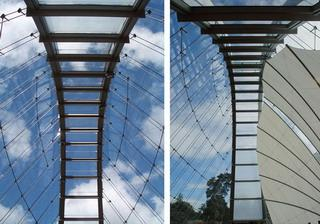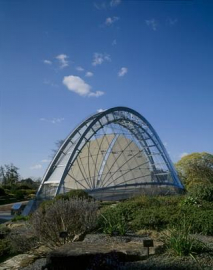Davies Alpine House in Richmond
This new glasshouse at the Royal Botanic Gardens Kew the first to be constructed there for over 20 years - combines sustainability, technology and accessibility in an architecture that is both pragmatic and arresting, reflecting the clients ongoing commitment to public education, accessibility and world-leading research.
Following Wilkinson Eyres preparation of a Site Development Plan for Kew, we were approached by the client to develop a design for a new Alpine House. The previous structure was inadequate in terms of the technical growing requirements of alpine plants, and poorly located for public access. It was essential that the new glasshouse should not only resolve these issues but also act to raise the profile of Kews world renowned collection of alpine plants, long considered a lost gem. It was also important that it demonstrated the same spirit of innovation and quality of design as seen in Kews other famous historic glasshouses, particularly within the context of the gardens listing in 2003 as a UNESCO World Heritage Site.
The location of the new Alpine House successfully meets these aspirations, the structure creating a new gateway to Kews Rock Garden and a new focal point for this part of the site. The ground floor follows the slope of the Rock Garden to minimise disruption to existing planting and to create a seamless transition between inside and out.
The building has been designed to passively encourage the environmental conditions required for the successful growing of alpine plants high light levels, cool conditions and constant air movement and circulation. It is conceived as two back-to-back twin arches which create the necessary height required to induce the stack effect in as elegant a form as possible within a small footprint. Below ground, air is cooled in a labyrinth within a double concrete slab, inspired by the natural cooling strategy utilised in termite ant nests. This cooled air is then recirculated around the perimeter of the house and onto the low-level plants. The stack effect helps to avoid overheating at plant level by drawing the warm air out of the building via the opening vents at the top of the structure.
Stainless steel tension rods span between each of the twin arches, anchoring to the base and transferring loads to the concrete retaining wall. The surface between the arches is formed of structural glazing, and has a strong geometry resembling a cut segment from a cylinder. In order to minimise direct sunlight, the house is oriented from north to south so that only one of the narrow ends is south facing. Similarly, the glazed cladding panels are faceted meaning that direct sunlight is only concentrated on a single facet at any one time. An innovative shading solution, developed using yacht technology and based on a fan-like form similar to a peacocks tail, assists in keeping temperatures at the required levels.









